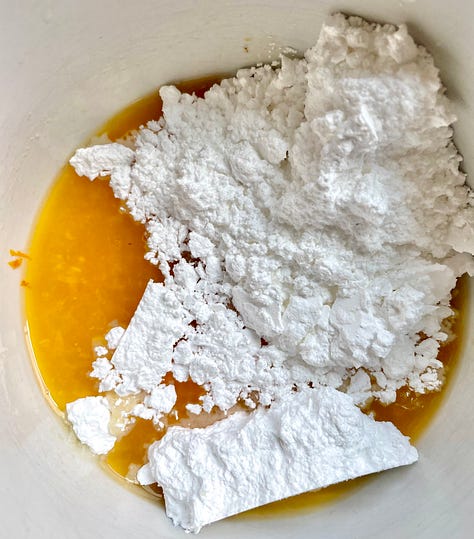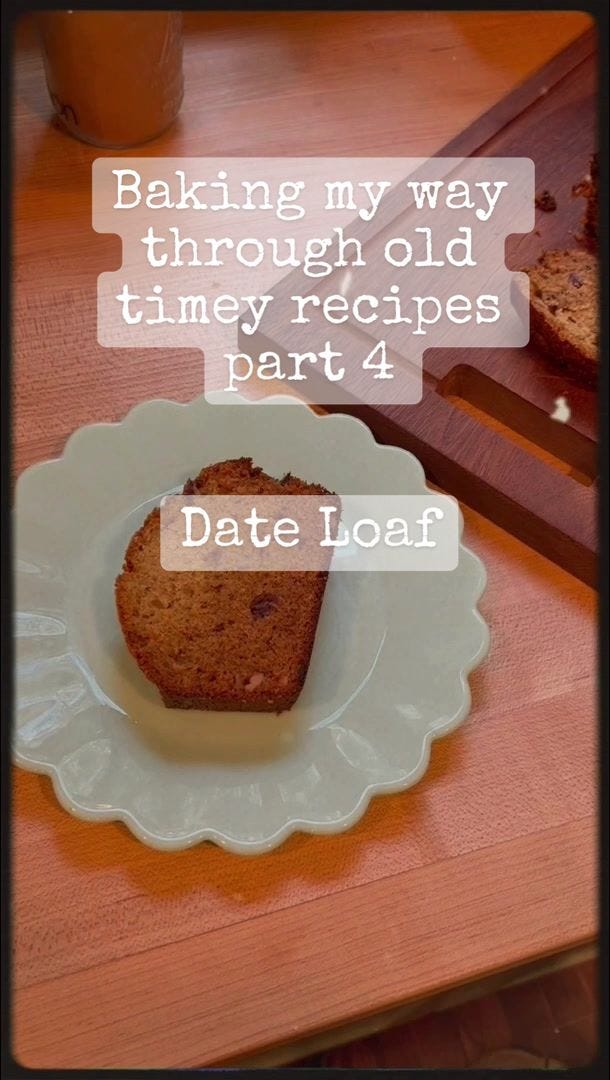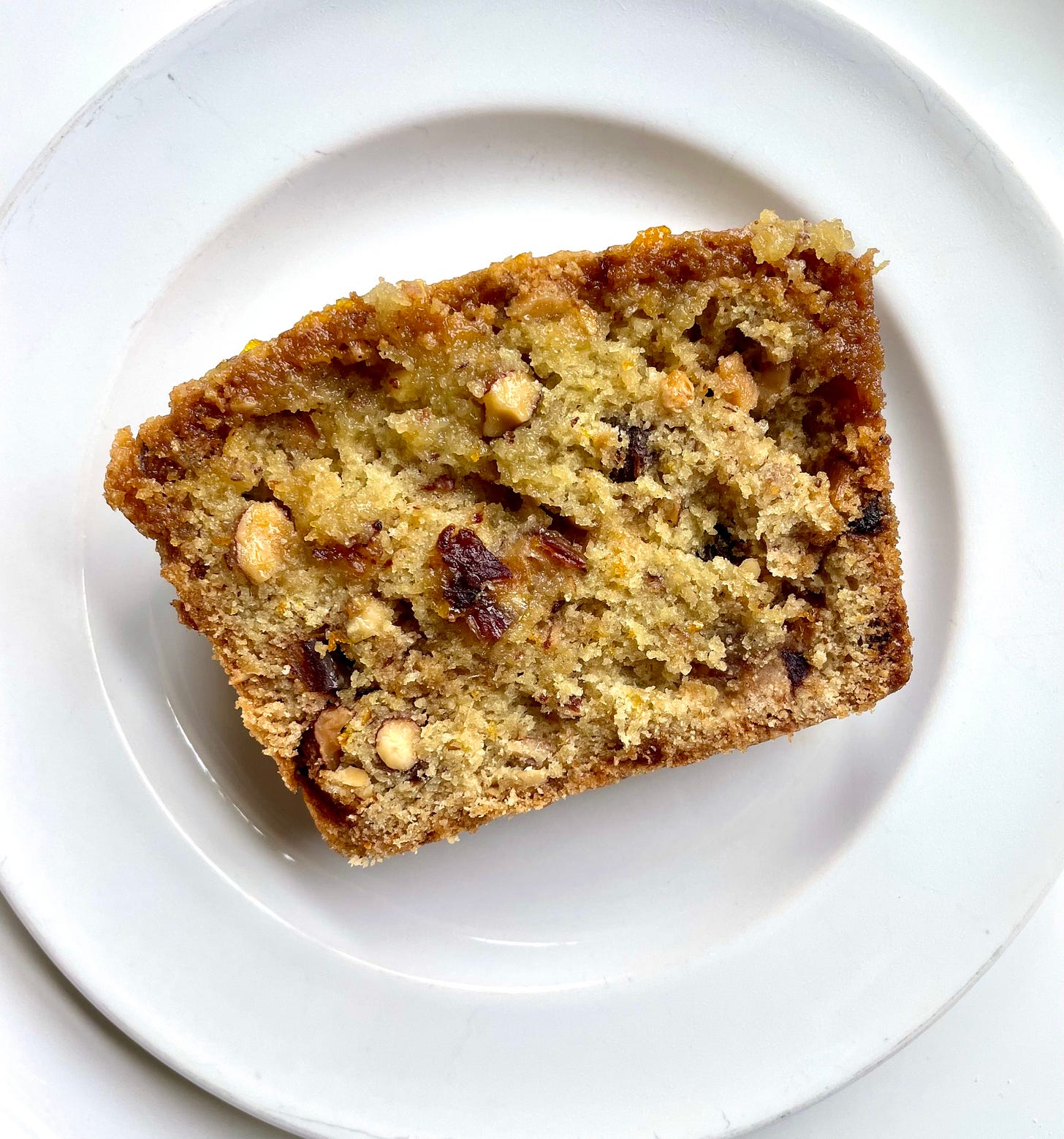My grandmother hated this cake: Vintage Recipe Roulette with Orange Cake
Why did this hot mess of a recipe raise all 4 feet, 11 inches of her ire? Let's find out
In case this is your first time visiting the Department of Antediluvian Disquietude and you missed the first installment, this is the latest in a series of Vintage Recipe Roulette reviews using only recipes from Talk About Good, my grandmother’s 1975 community church cookbook. In just 164 pages, this collection of homestyle recipes encapsulates the unlikely intersections of 1800s frontier cuisine, post-war convenience foods, and the mid-century American fetishization of canned chow mein noodles. It is untested, unstandardized, and unmatched in its vintage glory in my opinion. Some of the recipes are amazingly good! And some are amazingly…not. Today, we summon up a real devil of a recipe…Orange Cake.
One of the things I love most about having my grandmother’s recipe book is that she made little notes in it — an extra 2 T of sugar here, add a 1/4 c of cocoa there — but there’s one recipe in particular that was singled out for special treatment:
My grandmother was one of the most devout people I ever knew. After a lifetime of more hardship and grief than most people ever face, she had a pretty good handle on do unto others, and she rarely spoke a harsh word about anyone, although she might call out unjust behavior in private conversations. That’s why I find the giant X drawn across this recipe so fascinating. How bad would a recipe have to be for her, someone whose favorite hymn was “Amazing Grace”, to find it wholly irredeemable? What was it in particular that lead her to leave this cake outside the boundless arms of Jesus? There’s no clue.
I’ve always wanted to make it out of morbid curiosity, so let’s sprinkle some holy water and get going! Here are the main ingredients:
For the record, I’m using vegan butter instead of Crisco on principle, but other than that I’m following the recipe right down to freshly squeezing the orange juice for the icing. My grandmother loved oranges and dates, and so do I. Just looking at those ingredients is reminiscent of holiday baking with her. It’s hard not to be just a teeny bit optimistic that this will turn out well despite early indicators.



As I mix it up, though, I get a sinking feeling. The batter is not at all pourable the way any quick bread should be. I wonder whether an ingredient has gone missing — perhaps there’s supposed to be orange juice in the batter as well? I read it several times looking for something else mentioned in the instructions not listed at the top, as often happens with community cookbooks. But no…I’ve made half the recipe, fashioning an aluminum foil wall to keep it contained to half the space, and it fills the pan almost to the rim. If it had more liquid, it wouldn’t fit. Nothing to do now but bake it and find out!
I thought it might take less time since it’s only half a loaf, but it took more — an hour and 10 minutes even though I used room temp butter and eggs, and even though the batter was so heavy that it pushed my impenetrable foil wall into just 1/3 of the pan. The usual technique for testing cake doneness is to press the top lightly — it should bounce back. The top of this “cake” doesn’t so much bounce as thumb its nose. It might as well be wearing chain mail. As I poked a skewer into the middle to make sure it came out clean, I could feel that the texture is unusually solid, and the pan weighs a ton. Ultimately I used a thermometer to make sure it was at least 200 degrees, the temp most cakes and quick breads need to reach so they’re not pasty, but I had to put it back in the oven twice just to get it to 198. Yikes…but it doesn’t look too bad?
Now to the icing, which is really more like a glaze…and I am puzzled anew. It doesn’t say anything about poking holes to let it soak in, but if I don’t do that, it’s going to pour over the sides of the pan. There’s a crack in it anyway, so I would also be risking the center being soaked and the bottom being dry. I split the difference, poke a few holes, and also make sure some of the glaze soaks down the sides. I got covered in sticky orange glaze and had to wipe down the counter, too.
Although it doesn’t specify, I let it cool to room temp before slicing. I say “slicing”, but it was more like sawing. The sides, and bottom are tough as shoe leather. I made another slice to make sure the center was cooked, and it is, but it’s super stodgy. The glaze soaked into the top some, but the sides and bottom are hard and dry, with just a coating of glaze on the outside. The parts with enough glaze for a decent texture are incredibly sticky.
The underlying flavor is nice, definitely reminiscent of other vintage date recipes, but there’s a bit too much zest flavor and not enough fruity flavor. At the same time, the parts soaked in icing are waaaaaay too sweet. The dates don’t stand out like they do in recipes where they really shine — old-fashioned date bars, or the Date Nut Loaf in B. Dylan Hollis’ Baking Yesteryear, for instance.

 Tiktok failed to load.
Tiktok failed to load.Enable 3rd party cookies or use another browser
So what went wrong? Looking at the recipe before baking, I noted a few areas of concern:
There’s relatively little leavening, and what there is consists of baking soda, which doesn’t rise without acid the way baking powder does. With no OJ or buttermilk in the batter, what little soda there is may not even be activated.
It’s almost like a drop cookie recipe in terms of liquid:oil:dry ingredient ratios, but it’s in a solid block loaf shape, which complicates baking time and compromises crumb texture. Most of the liquid is reserved for the glaze.
It’s uncommon to have glaze poured on a cake while hot, but not unheard of. The issue is that this usually results in a pudding-like cake, and if the batter is heavy, adding a glaze while hot is likely to offer up a texture like unset plaster.
The real reason this recipe earned a dreaded and unprecedented Dark Mark from my sweet little grandmother? It’s ALL of those things, and more. It plain ol’ doesn’t work as written, and I should have known if it had been fewer sins than that, she probably would have just made a note or two. The baking time shown is too short, and as the minutes tick by, it gets drier and drier on the outside just to make sure there’s not a pool of sludge on the inside. There’s too much batter to fit in a standard loaf pan, and it rises above the rim even when it had foil to push out of the way. If I had made the whole recipe, I think it might have overflowed like gluten-y lava. Even if it doesn’t actually spill out, when you pour over the glaze, it’s gonna make a mess unless you really fiddle with it, poking holes and prying the sides away from the pan. She just couldn’t abide a recipe that didn’t make any sense, especially for a wet sugared cement result.
If you’d like to try making this, and you shouldn’t, try adding a half teaspoon of baking POWDER, and maybe another 1/2 c of orange juice added to the batter to improve leavening and moisture. Then, bake it in a 9x9 pan instead of a loaf pan. Be careful with the baking time — hopefully it would be done in more like 40 minutes so that the bottom doesn’t dry so much, but it might need a little more. Poke some holes all the way to the bottom before pouring on the glaze.
The instructions say it keeps for a week, wrapped, but that’s a long time to leave this thing on your counter, where it can plot your undoing in between casting evil spells.
Take it from my grandmother — there’s just no saving this one.
Zen and the Science of Candy Corn is a reader-supported publication that brings me great joy. You can literally give me your 2 cents with the tip jar button below!
Of course, if you’d like to subscribe, free or paid? That would be heavenly.
And please feel free to share this post with any cement cake-loving psychopaths you know.










Think I’ll pass. 😂
Why thank you for recipe and advice. I do love all those ingredients. And might venture to make but with extra moisture, maybe buttermilk, some oil, etc. I love anything orange.